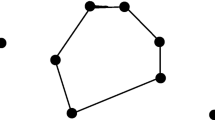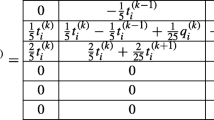Abstract
The finite element method is based on the division of the physical domains into a large number of small polytopes with simple geometry. Basically, the most useful finite elements can be divided into two large groups: simplicial elements and hypercubic elements. To keep conformity, triangulating of curved domains with complex geometry requires the usage of various kinds of transitional elements, which are specific for any fixed Euclidean space. The paper deals with a basic problem of the finite element method in the multidimensional spaces - conforming coupling between hypercubic and simplicial meshes. Here we focus on the bipyramidal elements. Some properties of such kind elements are discussed in an arbitrary Euclidean space with a dimension greater than two.
Access this chapter
Tax calculation will be finalised at checkout
Purchases are for personal use only
Similar content being viewed by others
References
Ainsworth, M., Fu, G.: A lowest-order composite finite element exact sequence on pyramids. Comput. Methods Appl. Mech. Eng. 324, 110–127 (2017)
Bedrosian, G.: Shape functions and integration formulas for three-dimensional finite element analysis. Internat. J. Numer. Methods Engrg. 35, 95–108 (1992)
Bedregal, C.: Maria-Cecilia Rivara, Longest-edge algorithms for size-optimal refinement of triangulations. Comput. Aided Des. 46, 246–251 (2014)
Bergot, M., Cohen, G., Duruflé, M.: Higher-order finite elements for hybrid meshes using new nodal pyramidal elements. J. Sci. Comput. 42, 345–381 (2010)
Bey, J.: Simplicial grid refinement, On Freudenthal’s algorithm and the optimal number of congruence classes. Numer. Math. 85(1), 1–29 (1998)
Brandts, J., Korotov, S., Křížek, M.: Simplicial finite elements in higher dimensions. Appl. Math. 52(3), 251–265 (2007)
Ca, C., Qin, Q.-H., Yu, A.: A new hybrid finite element approach for three-dimensional elastic problems. Arch. Mech. 64(3), 261–292 (2012)
Coulomb, J.-L., Zgainski, F.-X., Marechal, Y.: A pyramidal element to link hexahedral, prismatic and tetrahedral edge finite elements. IEEE Trans. Magn. 33(2), 1362–1365 (1997)
Devloo, P., Duran, O., Gomes, S., Ainsworth, M.: High-order composite finite element exact sequences based on tetrahedral-hexahedral-prismatic-pyramidal partitions. hal-02100485 (2019)
Hannukainen, A., Korotov, S., Křížek, M.: On numerical regularity of the face-to-face longest-edge bisection algorithm for tetrahedral partitions. Sci. Comput. Programm. 90(Part A) (2014) Pages 34–41
Hermosillo-Arteaga, A., Romo-Organista, M., Magaña del Toro, R., Carrera-Bolaños, J.: Development of a refinement algorithm for tetrahedral finite elements. Rev. Int. métodos numér. cálc. diseño ing. 37(1), 1–21 (2021)
Korotov, S., Plaza, Á., Suárez, J.P.: Longest-edge n-section algorithms: properties and open problems. J. Comput. Appl. Math. 293, 139–146 (2016)
Luo, X., Wang, Z., Wang, M., Shi, X.: A variable-scale refinement triangulation algorithm with faults data. J. Comput. 31(5), 212–223 (2020)
O’Malley, B., Kophazi, J., Eaton, M.D., Badalassi, V., Warner, P., Copestake, A.: Pyramid finite elements for discontinuous and continuous discretizations of the neutron diffusion equation with applications to reactor physics. Prog. Nucl. Energy 105, 175–184 (2018)
Martinelli, L.B., Alves, E.C.: Optimization of geometrically nonlinear truss structures under dynamic loading. REM Int. Eng. J. 73(3), 293–301 (2020)
Petrov, M.S., Todorov, T.D.: Properties of the multidimensional finite elements. Appl. Math. Comput. 391, 125695 (2021)
Petrov, M.S., Todorov, T.D.: Refinement strategies related to cubic tetrahedral meshes. Appl. Numer. Math. 137, 169–183 (2019)
Petrov, M.S., Todorov, T.D., Walters, G., Williams, D.M., Witherden, F.D.: Enabling four-dimensional conformal hybrid meshing with cubic pyramids. Numer. Algorithms (to appear)
Pascucci, V.: Slow growing subdivision (SGS) in any dimension: towards removing the curse of dimensionality. EUROGRAPHICS 21(3), 451–460 (2002)
Perdomo, F., Plaza, Á.: Properties of triangulations obtained by the longest-edge bisection. Central Eur. J. Math. 12(12), 1796–1810 (2014). https://doi.org/10.2478/s11533-014-0448-4
Ray, N., Sokolov, D., Reberol, M., Ledoux, F., Lévy, B.: Hex-dominant meshing: mind the gap! Comput. Aided Des. 102, 94–103 (2018)
Verstraaten, T.W., Kosinka, J.: Local and hierarchical refinement for subdivision gradient meshes. Pac. Graph. 37(7), 373–383 (2018)
Yamakawa, S., Gentilini, I., Shimada, K.: Subdivision templates for converting a non-conformal hex-dominant mesh to a conformal hex-dominant mesh without pyramid elements. Eng. Comput. 27, 51–65 (2011)
Yamakawa, S., Shimada, K.: Fully-automated hex-dominant mesh generation with directionality control via packing rectangular solid cells. Int. J. Numer. Methods Eng. 57, 2099–2129 (2003)
Yamakawa, S., Shimada, K.: Increasing the number and volume of hexahedral and prism elements in a hex-dominant mesh by topological transformations. IMR, 403–413 (2003)
Author information
Authors and Affiliations
Editor information
Editors and Affiliations
Rights and permissions
Copyright information
© 2021 Springer Nature Switzerland AG
About this paper
Cite this paper
Petrov, M.S., Todorov, T.D. (2021). Properties of Multipyramidal Elements. In: Gervasi, O., et al. Computational Science and Its Applications – ICCSA 2021. ICCSA 2021. Lecture Notes in Computer Science(), vol 12949. Springer, Cham. https://doi.org/10.1007/978-3-030-86653-2_40
Download citation
DOI: https://doi.org/10.1007/978-3-030-86653-2_40
Published:
Publisher Name: Springer, Cham
Print ISBN: 978-3-030-86652-5
Online ISBN: 978-3-030-86653-2
eBook Packages: Computer ScienceComputer Science (R0)




